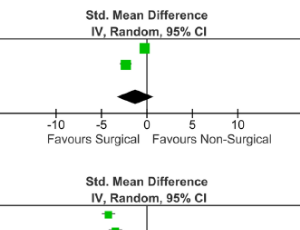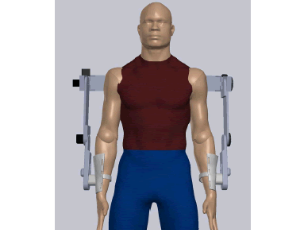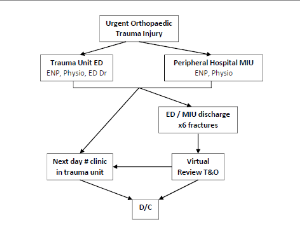Loading
Archives of Orthopaedics
ISSN: 2692-8299


Chaoyang Chen
Detroit Medical Center, USA
Featured Article
Surgical Fixation of Severe Rib Fractures: A Systematic Literature Review and Meta-Analysis

Featured Article
Performance Validation of An Upper Limb Exoskeleton Using Joint ROM Signal

Featured Article
Efficacy of a Virtual Fracture Clinic Model Created During Covid-19 Pandemic

About this Journal
Archives of Orthopaedics is a peer reviewed online publication launched by Scientific Archives in effective collaboration with orthopaedicians, researchers, clinicians and doctors across the globe. The journal is launched with the aim of initiating forums and hubs for discussing research findings related to Orthopaedic health care. The journal publishes high impact research ideas and discoveries related to main subjects in Orthopaedics such as arthritis, rheumatology, joint injuries, orthoapaedic surgery, spinal cord injury etc.
Articles
Atypical Presentation of Tibia and Fibula Fracture in an Old Woman - Case Report
This case report presents the clinical details, diagnostic findings, and management of a 64-year-old female patient who suffered a tibia and fibula fracture, presented in an atypical manner, after twisting her ankle during daily activities. The medical background, physical examination, radiological results, and course of treatment of the patient are detailed.
Doctor, Can We Reuse this Brace; Patient Attitudes towards Reuse of Orthopedic Braces
Introduction: Climate change presents an important threat to human health and wellbeing. Paradoxically, many facets of healthcare provision contribute significantly to greenhouse gas emissions. An important example of this is the use of single use, disposable orthopedic orthotics, widely dispensed in emergency departments and fracture clinics. This study aimed to understand patients’ attitudes towards climate change, single use plastics, and recycling of orthotics.
The Incidence and Risk Factors of Pelvic Stress Fracture, Delayed-healing and Non-union Following Periacetabular Osteotomy in Adolescents
Background: Periacetabular Osteotomy (PAO) is a well-established procedure, however more prospective cohort studies are required to assess all clinical factors related to this invasive intervention. The aims of this study are as follows 1) quantifying stress fractures, delayed-healing and non-union post PAO and 2) to correlate possible risk factors for developing symptomatic stress fracture, delayed-healing or non-union.
Evaluation of Patellofemoral Complications by Comparing the Medial Parapatellar and Subvastus Approaches
Total knee arthroplasty (TKA) is considered to be the best method for treating advanced knee osteoarthritis in terms of reducing pain, improving joint functions, and increasing the patient’s quality of life. The most commonly used approach in TKA is the standard medial parapatellar (MPP) approach described by Insall. The MPP approach provides a good view of the operating field.
Performance Validation of An Upper Limb Exoskeleton Using Joint ROM Signal
Upper extremity (UE) exoskeletons were developed for industrial applications where assistive force enhancement was needed, but there have also been developments for use in telemanipulation and virtual reality, clinical applications such as assistance in orthopedic surgery, and orthopedic rehabilitation.
A Pilot Study for Assessing a Novel Method of Measuring Shoulder Activation in Healthy Volunteers Using Surface Electromyography
Over the years, healthcare providers have used a host of physical examinations and clinical tools to assess a patient’s physical functioning and health, but many of these assessment tools lack generalizability among physicians or the specificity and sensitivity to accurately diagnose a patient. Range of motion measures are one-way physicians assess many physical deficiencies in the upper and lower extremity.
Submuscular Anterior Transposition for Treatment of Ulnar Nerve Syndrome: Outcomes and Final Satisfaction
Ulnar neuropathy is the second most common peripheral neuropathy in the upper limb after carpal tunnel syndrome, with an incidence of 30 cases per 100,000 persons/year. It is characterized by the appearance of sensory symptoms such as pain, dysesthesia, and paresthesia, initially intermittent and then continuous, in the ulnar territory of the forearm and hand.
Hamstrings Injuries with MRI Findings in a Major League Soccer Team
Hamstring injuries are the most common pathology reported in professional soccer players and represent about 10-30% of all injuries. The hamstring complex is comprised of three muscles located in the posterior compartment of the thigh including the semimembranosus (SM), semitendinosus (ST), and biceps femoris (BF), which is comprised of the long head (BFLH) and short head (BFSH).
Incidental Spinal Durotomies Noted During Spinal Surgery: Incidence and Management
An incidental durotomy or dural tear is defined by ICD- 10 as an accidental puncture or laceration of dura during a procedure. These procedures include spinal surgery and interventional procedures such as epidural injection. The published incidence of incidental durotomy varies in the literature and is dependent on the procedure being performed, the experience of the surgeon, and patient factors but can range from 1% to 17%.
Improve the Efficiency of the Yaskawa Motoman MH5 Robot for Utilization in Robot-Assisted Orthopedic Surgery
Using robots in surgeries dates back to the mid-1980s. The robotic was applied in a wide range of biological and medical sciences such as clinical medicine, neuroscience, cardiovascular, dentofacial, and cellular and molecular life sciences. Orthopedic robots are much more widely used and complex in medical engineering sciences.
Bacterial Biofilms and Implant Infections: A Perspective
Human body implants are rapidly covered by a conditioning film (which contains the biochemical moieties) when they interact with human body fluids and its components. This surface-bound biochemical blend elicits a chemotactic response to attract bacteria that are transmitted through infection or by contamination.
The use of Percutaneous Achilles’ Tendon Lengthening as an Adjunct Procedure in Foot and Ankle Surgery: A Review
The goal of reconstructive foot and surgery for diabetic foot pathologies is to create a plantigrade foot that is braceable and has low risk of ulcer formation or recurrence. Experienced surgeons are cognizant that foot pathologies are defined in three planes: frontal, transverse and sagittal. The Achilles’ tendon is the chief deforming force in the foot along the sagittal plane.
Epidemiology of Displaced Supracondylar Fractures
Supracondylar fractures of the humerus are the most common elbow fracture in the pediatric population and comprise nearly 60% of all elbow fractures. Supracondylar fractures most commonly occur in children aged five to seven. Historically, males had a higher incidence of supracondylar humeral fractures. More recent studies support a more equal distribution amongst males and females.
Clinical and Histological Proof that Surgical Incisions along Skin Folding Lines Result in Optimal Scars
In an early publication, we could show that striae distensae always develop perpendicular to the skin tension lines. In another article, we demonstrated that virtual skin tension lines are identical to the obvious Main Folding Lines; we recommended their use as optimal directions for orthopedic incisions, when inconspicuous scar formation is a prerequisite, as in children, younger adults, and women.
The Role of the MPFL and MPTL in Patellar Stability – A Biomechanical Study
The medial patellofemoral ligament (MPFL) is a thickened band of tissue that originates from the adductor tubercle and inserts on the proximal medial patella. It is expected that the MPFL, under patellar lateral subluxation, will fail at approximately 12-18 mm of displacement due to the failing of collagen based structures at 20% to 30% elongation.
Atypical Presentation of Tibia and Fibula Fracture in an Old Woman - Case Report
This case report presents the clinical details, diagnostic findings, and management of a 64-year-old female patient who suffered a tibia and fibula fracture, presented in an atypical manner, after twisting her ankle during daily activities. The medical background, physical examination, radiological results, and course of treatment of the patient are detailed.
Surgical Fixation of Severe Rib Fractures: A Systematic Literature Review and Meta-Analysis
Rib fractures are a commonly encountered traumatic injury and are associated with significant morbidity and mortality. They are a marker of severe injury and can lead to defects in the chest wall and severe pain which may hinder breathing.
Performance Validation of An Upper Limb Exoskeleton Using Joint ROM Signal
Upper extremity (UE) exoskeletons were developed for industrial applications where assistive force enhancement was needed, but there have also been developments for use in telemanipulation and virtual reality, clinical applications such as assistance in orthopedic surgery, and orthopedic rehabilitation.
Efficacy of a Virtual Fracture Clinic Model Created During Covid-19 Pandemic
The COVID-19 pandemic has caused delivery of orthopaedic services to require extra consideration and substantial revision. Alternative ways to manage patients with urgent injuries have been instigated to minimize patient’s exposure to the disease, spread within the hospital system and reduce the overall impact on stretched resources.
The use of Percutaneous Achilles’ Tendon Lengthening as an Adjunct Procedure in Foot and Ankle Surgery: A Review
The goal of reconstructive foot and surgery for diabetic foot pathologies is to create a plantigrade foot that is braceable and has low risk of ulcer formation or recurrence. Experienced surgeons are cognizant that foot pathologies are defined in three planes: frontal, transverse and sagittal. The Achilles’ tendon is the chief deforming force in the foot along the sagittal plane.
The Role of the Sciatic Nerve Ultrasound Elastography in the Clinical Pathway: A Meta-analysis
Ultrasound elastography is a diagnostic method, to measure elasticity and strain in tissues and organs. The aim of this review was to highlight the usefulness of sciatic nerve ultrasound elastography in clinical practice. Different changes affect the sciatic nerves through various diseases and conditions.
About Scientific Archives
Scientific Archives is a global publisher initiated with the mission of ensuring equal opportunity for accessing science to research community all over the world. Spreading research findings with great relevance to all channels without any barrier is our goal. We want to overcome the challenges of Open Access with ensured quality and transparency.
